Caddo
The Caddo Nation is a confederacy of several Southeastern Native American tribes. Their ancestors historically inhabited much of what is now East Texas, Louisiana, and portions of southern Arkansas and Oklahoma. They were descendants of the Caddoan Mississippian culture that constructed huge earthwork mounds at several sites in this territory. In the early 19th century, Caddo people were forced to a reservation in Texas; they were removed to Indian Territory in 1859.
Caddo Nation flag | |
| Total population | |
|---|---|
| 6,000 enrolled members (2017)[1] | |
| Regions with significant populations | |
| USA (currently Oklahoma, formerly Arkansas, Louisiana, Texas) | |
| Languages | |
| dialects of Caddo and English | |
| Religion | |
| Ghost Dance, Native American Church, Christianity | |
| Related ethnic groups | |
| Pawnee, Wichita, Kitsai Caddo Confederacy: |
Today, the Caddo Nation of Oklahoma is a federally recognized tribe with its capital at Binger, Oklahoma. Descendants of the historic Caddo tribes, with documentation of at least 1⁄16 ancestry, are eligible to enroll as members in the Caddo Nation. The several Caddo languages have converged into a single language.
Government and civic institutions
The Caddo Nation was previously known as the Caddo Tribe of Oklahoma. The tribal constitution provides for election of an eight-person council, with a chairperson, that is based in Binger, Oklahoma.[2]
The tribe operates its own housing authority and issues its own tribal vehicle tags. It also operates an administrative center, dance grounds, several community centers, the Caddo Nation Heritage Museum, and an active NAGPRA office, located south of Binger.[3] As of 2012, 5,757 people are enrolled in the nation, with 3,044 living within the state of Oklahoma.[3] Individuals are required to document at least 1/16 Caddo ancestry in order to enroll as citizens.
In July 2016, Tamara M. Francis was re-elected as the Chairman of the Caddo Nation. Chairman Tamara Francis is the daughter of the first elected female Chairman, Mary Pat Francis. She is the fourth elected female leader of the Caddo Nation. The council consists of:
- Chairman: Tamara M. Francis
- Vice-Chairman: Carol D. Ross
- Acting Secretary: Philip Martin
- Treasurer: Marilyn McDonald
- Oklahoma City Representative: Jennifer Wilson
- Binger Representative: Marilyn Threlkeld
- Fort Cobb Representative: Maureen Owings.
The tribe has several programs to invigorate Caddo culture. It sponsors a summer culture camp for children.[4] The Hasinai Society[5] and Caddo Culture Club[6] both teach and perform Caddo songs and dances to keep the tradition alive and pass it on to the next generations. The Kiwat Hasinay Foundation is dedicated to preserving and increasing use of the Caddo language.[7]
Pre-contact history
Archaeology

The Caddo are thought to be an extension of Woodland period peoples, the Fourche Maline and Mossy Grove cultures, whose members were living in the area of Arkansas, Louisiana, Oklahoma, and Texas between 200 BCE and 800 CE.[8] The Wichita and Pawnee are related to the Caddo, as both tribes speak Caddoan languages.
By 800 CE, this society had begun to coalesce into the Caddoan Mississippian culture. Some villages began to gain prominence as ritual centers. Leaders directed the construction of major earthworks, serving as temple mounds and platforms for residences of the elite. The flat-topped mounds were arranged around leveled, large, open plazas, which were usually kept swept clean and were often used for ceremonial occasions. As complex religious and social ideas developed, some people and family lineages gained prominence over others.[8] By 1000 CE, a society that is defined by archaeologists as "Caddoan" had emerged. By 1200, the many villages, hamlets, and farmsteads established throughout the Caddo world had developed extensive maize agriculture, producing a surplus that allowed for greater density of settlement.[8] In these villages, artisans and craftsmen developed specialties. The artistic skills and earthwork mound-building of the Caddoan Mississippians flourished during the 12th and 13th centuries.[9]
The Spiro Mounds, near the Arkansas River in present-day southeastern Oklahoma, were some of the most elaborate mounds in the United States. They were made by Mississippian ancestors of the historic Caddo and Wichita tribes, in what is considered the westernmost point of the Mississippian culture.[10] The Caddo were farmers and enjoyed good growing conditions most of the time. The Piney Woods, the geographic area where they lived, was affected by the Great Drought from 1276–1299 CE, which covered an area extending to present-day California and disrupted many Native American cultures.[11]
Archeological evidence has confirmed that the cultural continuity is unbroken from prehistory to the present among these peoples. The Caddoan Mississippian people were the direct ancestors of the historic Caddo people and related Caddo-language speakers who encountered the first Europeans, as well as of the modern Caddo Nation of Oklahoma.[12]
Oral history
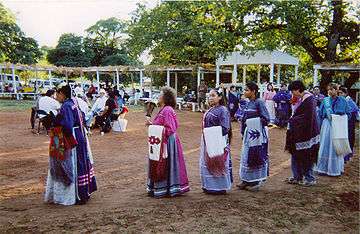
Caddo oral history of their creation story says the tribe emerged from a cave, called Chahkanina or "the place of crying," located at the confluence of the Red River of the South and Mississippi River in northern present-day Louisiana. Their leader, named Moon, instructed the people not to look back. An old Caddo man carried with him a drum, a pipe, and fire, all of which have continued to be important religious items to the people. His wife carried corn and pumpkin seeds. As people and accompanying animals emerged, the wolf looked back. The exit from the underground closed to the remaining people and animals.[13]
The Caddo peoples moved west along the Red River, which they called Bah'hatteno in Caddo.[14] A Caddo woman, Zacado, instructed the tribe in hunting, fishing, home construction, and making clothing. Caddo religion focuses on Kadhi háyuh, translating to "Lord Above" or "Lord of the Sky." In early times, the people were led by priests, including a head priest, the xinesi, who could commune with spirits residing near Caddo temples.[13] A cycle of ceremonies developed around important periods of corn cultivation. Tobacco was and is used ceremonially. Early priests drank a purifying sacrament made of wild olive leaves.[15]
Territory
Centuries before extensive European contact, some of the Caddo territory was invaded by migrating Dhegihan-speaking peoples, Osage, Ponca, Omaha, and Kaw, who moved west beginning about 1200 due to years of warfare with the Iroquois in the Ohio River area of present-day Kentucky. The Iroquois took control of hunting grounds in the area. The Osage particularly fought the Caddo, pushed them out of some former territory, and became dominant in the region of present-day Missouri, Arkansas, and eastern Kansas. These tribes had become settled in their new territory west of the Mississippi prior to mid-18th-century European contact.[16]
Most of the Caddo historically lived in the Piney Woods ecoregion of the United States, divided among the state regions of East Texas, southern Arkansas, western Louisiana, and southeastern Oklahoma. This region extends up to the foothills of the Ozarks. The Piney Woods are a dense forest of deciduous and pinophyta flora covering rolling hills, steep river valleys, and intermittent wetlands called "bayous". Caddo people primarily settled near the Caddo River.
When they first encountered Europeans and Africans, the Caddo tribes organized themselves in three confederacies: the Natchitoches, Hasinai, and Kadohadacho. They were loosely affiliated with other neighboring tribes including the Yowani a Choctaw band. The Natchitoches lived in now northern Louisiana, the Haisinai lived in East Texas, and the Kadohadacho lived near the border of Texas, Oklahoma, and Arkansas.[17]
The Caddo people had a diet based on cultivated crops, particularly maize (corn), but also sunflower, pumpkins, and squash. These foods held cultural significance, as did wild turkeys. They hunted and gathered wild plants, as well.
Culture and gender
The Caddo Native Americans contained a culture that consisted of the hunting and gathering dynamic. The men took over the duties of hunting year round, while the young and healthy women were in charge of the gathering of the tribe. Elderly women planted the seeds for the seasons' crop. Gathered materials included corn, sunflowers, beans, melons, tobacco, and squash during the warm seasons and acorns and roots to provide food other than meat in the cold seasons when crops wouldn't grow.[18][19] While hunting, the men used handcrafted bows and arrows to hunt animals such as wild turkey, quail, rabbits, bears, and buffalo during winter months.[18][19] Besides the tools for searching for animals, most tools and items were made by women. They would make wooden mortars, as well as pots and other utensils out of clay. These wood and clay tools were carved and molded to help with daily jobs like cooking the meals for the tribe. These tools were seen with such importance that men and women were buried with the items that they had made.[20]
The Caddo also had a focus on the decorating of the body. Men favored temporary body modifications such as the painting of skin, jewelry, ear piercing, or hair decorations, like braids, mixed in with bird feathers or animal fur. While the women of the tribe still wore jewelry and styled their hair similarly to men, most female were interested in the art of tattooing the body. Such tattoos covered most of the body, including the face.[18]
Post-contact history
%2C_1906.jpg)
The Caddo first encountered Europeans and Africans in 1541 when the Spanish Hernando de Soto Expedition came through their lands.[21] De Soto's force had a violent clash with one band of Caddo Indians, the Tula people, near present-day Caddo Gap, Arkansas. This historic event has been marked by the modern town with a monument.
French explorers in the early 18th century encountered the Natchitoche in northern Louisiana. They were followed by fur traders from outposts along the Gulf Coast, and later by missionaries from France and Spain, who also traveled among the people. The Europeans carried infections such as smallpox and measles, because these were endemic in their societies. As the Caddo peoples had no acquired immunity to such new diseases, they suffered epidemics with high fatalities that decimated the tribal populations. Influenza and malaria also devastated the Caddo.[16]
French traders built forts with trading posts near Caddo villages, that already were important hubs in the Great Plains trading network. These stations attracted more French and other European settlers. Among such settlements are the present-day communities of Elysian Fields and Nacogdoches, Texas, and Natchitoches, Louisiana. In the latter two towns, early explorers and settlers kept the original Caddo names of the villages.
Having given way over years before the power of the former Ohio Valley tribes, the later Caddo negotiated for peace with the waves of Spanish, French, and finally Anglo-American settlers. After the 1803 Louisiana Purchase, by which the United States took over the former French colonial territory west of the Mississippi River, the US government sought to ally with the Caddo peoples. During the War of 1812, American generals such as William Henry Harrison, William Clark, and Andrew Jackson crushed pro-British uprisings among other Southeast Indians, in particular the Creeks. Due to the Caddo's neutrality and their importance as a source of information for the Louisiana Territory government, they were left alone. In the 1830s, the federal government embarked on a program of Indian removal of tribes from the Southeast in order to enable European-American settlement, as new migrants pressed from the east.[22]
In 1835 the Kadohadacho, the northernmost Caddo confederacy, signed a treaty with the US to relocate to independent Mexico (in the area of present-day East Texas). Then lightly settled by Mexican colonists, this area was being rapidly transformed by greatly increased immigration of European Americans. In 1836, the Anglo-Americans declared independence from Mexico and established the Republic of Texas, an independent nation.[14] The name "Texas" is derived from the Hasinai word táysha, meaning "friend".[23]
On December 29, 1845, Texas was admitted to the US as a state. At that time, the federal government forced the relocation of both the Hasinai and the Kadohadacho as well as remnants of allied Delaware (Lenape) and Yowani onto the Brazos Reservation. Pressures increased on the Brazos Reservation Indians to remove north, culminating in a violent attack on December 26, 1858 on a Caddo encampment just off the reservation. This vigilante group led by Captain Peter Garland was a vigilante force from Erath County. The Caddo group was led by Choctaw Tom who was a Yowani Choctaw married to a Hasinai woman, who was killed in this fight along with twenty-seven other Indians.[24] In 1859, many of the Caddo were relocated again to Indian Territory north of Texas, in present-day Oklahoma. After the Civil War, the Caddo were concentrated on a reservation located between the Washita and Canadian rivers in Indian Territory.[14]
In the late 19th century, the Caddo took up the Ghost Dance religion, which was widespread among American Indian nations in the West. John Wilson, a Caddo-Lenape medicine man who spoke only Caddo, was an influential leader in the Ghost Dance. In 1880, Wilson became a peyote roadman. The tribe had known the Half Moon peyote ceremony, but Wilson introduced the Big Moon ceremony to them.[25] The Caddo tribe remains very active in the Native American Church today.
Late 19th century to present
Congress passed the Dawes Act to promote assimilation of tribes in Indian Territory. It authorized distribution of tribal communal landholdings into allotments for individual households in order for them to establish subsistence family farms along the European-American model. Any tribal lands remaining after such allotments were to be declared "surplus" and sold, including to non-Native Americans. The allotment system was intended to extinguish tribal Native American land claims to enable admission of Oklahoma as a state and assimilate Native Americans into the majority culture. At the same time, tribal governments were to be ended. The territory had already been settled by numerous European Americans outside the tribal territories.
The Caddo vigorously opposed allotment. Whitebread, a Caddo leader, said, "because of their peaceful lives and friendship to the white man, and through their ignorance were not consulted, and have been ignored and stuck away in a corner and allowed to exist by sufferance."[14] Tribal governments were dismantled at this time, and Native Americans were expected to act as state and US citizens. After some period, the adverse effects of these changes were recognized. The Caddo and other Native American peoples suffered greatly from the disruption of the loss of their lands and breakup of their traditional cultures.
Under the federal Indian Reorganization Act of 1934 and the Oklahoma Indian Welfare Act of 1936, the Caddo restored their tribal government. They adopted a written constitution and a process of electing officials. They organized in 1938 as the Caddo Indian Tribe of Oklahoma. They ratified their constitution on 17 January 1938.[2] In 1976, they drafted a new constitution, which continues elected representative government. During the 20th century, Caddo leaders such as Melford Williams, Harry Guy, Hubert Halfmoon, and Vernon Hunter have helped shape the tribe.[14]
In a special election on 29 June 2002, the tribe adopted six amendments to the constitution. Tribal enrollment is open to individuals with a documented minimum of 1/16 degree Caddo blood quantum.[27]
21st-century tribal issues
Sometimes, severe disagreements have developed among factions of the tribe that have not been resolved in elections. In August 2013, a group led by Philip Smith attempted to recall Brenda Shemayme Edwards, the chairman of the Tribal Council. This faction conducted a new election, but the victor stepped down, and Edwards refused to leave office. In October 2013, Smith and his supporters broke into the Caddo Nation headquarters. They chained the front doors from the inside and blocked off the entrance to the administration building. The opposition called the Bureau of Indian Affairs Police.[28]
Operation of the tribe was split between two factions. The Court of Indian Offenses, which had been overseeing issues for a year because of the internal conflict, in October 2014 ordered a new election for all positions.[29][30]
In the January 2015 elections, all the top tribal positions were won by women: Tamara Michele Francis as chair, Carol D. Ross as vice chair, Jennifer Reeder as secretary, and Wildena G. Moffer as treasurer.[31]
In July 2016, Tamara M. Francis was re-elected as the Chairman of the Caddo Nation. The Council consists of Chairman Francis, Vice Chairman Carol D. Ross, Acting Secretary Philip Martin, Treasurer Marilyn McDonald, Oklahoma City Representative Jennifer Wilson, Binger Representative Marilyn Threlkeld, Fort Cobb Representative Maureen Owings.
(Chairman Francis is the daughter of the first elected female Chairman, Mary Pat Francis. She is the fourth elected female leader of the Caddo Nation)
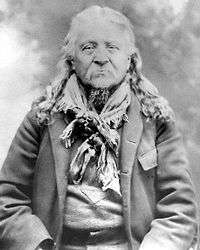 John Wilson (1840-1901), Caddo peyote roadman
John Wilson (1840-1901), Caddo peyote roadman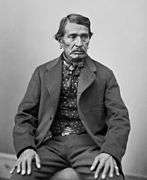 Sho-e-tat (Little Boy) or George Washington (1816-1883), Louisiana Caddo leader
Sho-e-tat (Little Boy) or George Washington (1816-1883), Louisiana Caddo leader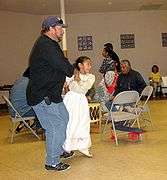 A stirrup dance by the Caddo Culture Club, Caddo National Complex, Binger, 2008
A stirrup dance by the Caddo Culture Club, Caddo National Complex, Binger, 2008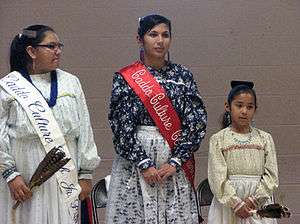 Caddo dancers, members of the Caddo Cultural Club, Binger, Oklahoma, 2008
Caddo dancers, members of the Caddo Cultural Club, Binger, Oklahoma, 2008
Notable Caddo
- T. C. Cannon, Kiowa-Caddo artist
- LaRue Parker, former tribal chairperson
- Jeri Redcorn, Caddo-Potawatomi potter
- John Wilson, peyote roadman
Notes
- "Enrollment". Caddo Nation. Archived from the original on 22 March 2017. Retrieved 21 March 2017.
- Constitution and By-Laws of the Caddo Indian Tribe of Oklahoma. Archived 2013-06-30 at Archive.today National Tribal Justice Resource Center. (retrieved 13 September 2009)
- 2011 Oklahoma Indian Nations Pocket Pictorial Directory. Archived April 24, 2012, at the Wayback Machine Oklahoma Indian Affairs Commission. 2011: 7. Retrieved 2 January 2012.
- Hasinai Summer Youth Camp. Hasinai Society. 2008 (retrieved 13 Sept 2009)
- General Information. Archived 2009-01-05 at the Wayback Machine Hasinai Society. 2008 (retrieved 13 Sept 2009)
- Edge, Donald. Caddo Culture Club. Archived 2009-07-04 at the Wayback Machine Caddo Nation: Heritage and Culture. (retrieved 13 Sept 2009)
- Background. Kiwat Hasinay Foundation.(retrieved 13 Sept 2009)
- "Tejas-Caddo Fundamentals-Caddo Timeline". Retrieved 2010-02-04.
- Carter, 17=8
- Fforde et al., 154
- "Great Drought". (2008). Encyclopædia Britannica. (Retrieved September 30, 2008). Encyclopædia Britannica Online
- "Tejas-Caddo Fundamentals-Caddoan Languages and Peoples". Retrieved 2010-02-04.
- Sturtevant, 625
- Meredith, Howard. "Caddo (Kadohadacho)," Encyclopedia of Oklahoma History and Culture, Oklahoma Historical Society, Accessed July 9, 2015.
- Sturtevant, 626
- Louis F. Burns, "Osage" Archived January 2, 2011, at the Wayback Machine Oklahoma Historical Society's Encyclopedia of Oklahoma History and Culture, retrieved 2 March 2009
- Sturtevant, 616–617
- Smith, F. Todd (Foster Todd), 1957– (1995). The Caddo Indians : tribes at the convergence of empires, 1542–1854 (1st ed.). College Station: Texas A & M University Press. ISBN 0890966427. OCLC 31435392.CS1 maint: multiple names: authors list (link)
- Swanton, John Reed, 1873–1958. (1996). Source material on the history and ethnology of the Caddo Indians (University of Oklahoma Press ed.). Norman: University of Oklahoma Press. ISBN 0585194211. OCLC 44961456.CS1 maint: multiple names: authors list (link)
- Carter, Cecile Elkins, 1928– (1995). Caddo Indians : where we come from. Norman: University of Oklahoma Press. ISBN 0585170495. OCLC 44964001.CS1 maint: multiple names: authors list (link)
- Sturtevant, 619
- Peter Kastor, The Nation's Crucible: The Louisiana Purchase and the Creation of America,(New Haven: Yale University Press, 2004) 159-160.
- Bolton 2002:63–64
- J.W. Wilbarger, Indian Depredations in Texas: Choctaw Tom Fort Tours http://www.forttours.com/pages/choctawtom.asp.
- Stewart, 86–88
- "Art on the Prairies". All About Shoes. Bata Shoe Museum. 2006. Retrieved 26 July 2015.
- Caddo Nation Constitutional Amendments. Archived 2010-06-02 at the Wayback Machine Caddo Nation. (retrieved 14 Sept 2009)
- M. Scott Carpenter, "Caddo Nation fight stops tribal government", The Journal Record, 1 October 2013, retrieved 10 Oct 2013 (subscription required)
- "Caddo Nation told to prepare for new election for all positions", Indianz.com, 7 October 2014
- Scott Rains, "Caddo Tribe To Get New Leadership", The Lawton Constitution, 10 October 2014, retrieved 2 Feb 2015
- "Women take chair and top tribal positions in Caddo Nation results", Indianz.com, 14 January 2015, accessed 14 January 2016
References
- Bolton, Herbet E. The Hasinais: Southern Caddoans As Seen by the Earliest Europeans. Norman: University of Oklahoma Press, 2002. ISBN 978-0-8061-3441-3.
- Carter, Cecile Elkins. Caddo Indians: Where We Come From, Norman: University of Oklahoma Press, 2001. ISBN 0-8061-3318-X
- Fford, Cressida, Jane Hubert, and Paul Turnbull. The Dead and their Possessions: Repatriation in Principle, Policy and Practice, New York: Routledge, 2004. ISBN 978-0-415-34449-4.
- Stewart, Omer Call. Peyote Religion: A History. Norman: University of Oklahoma Press, 1993. ISBN 978-0-8061-2457-5.
- Sturtevant, William C., general editor and Raymond D. Fogelson, volume editor. Handbook of North American Indians: Southeast. Volume 14. Washington DC: Smithsonian Institution, 2004. ISBN 0-16-072300-0.
Further reading
- Dorsey, George Amos. Traditions of the Caddo. Lincoln: University of Nebraska Press, 1997. ISBN 0-8032-6602-2
- LaVere, David. The Caddo Chiefdoms: Caddo Economics and Politics, 1700–1835. Lincoln: University of Nebraska Press, 1998. ISBN 0-8032-2927-5
- Newkumet, Vynola Beaver and Howard L. Meredith. Hasinai: A Traditional History of the Caddo People. College Station: Texas A&M Press, 1988. ISBN 0-89096-342-8
- Perttula, Timothy K. The Caddo Nation: Archaeological and Ethnohistoric Perspectives. Austin: University of Texas Press, 1997. ISBN 0-292-76574-6
- Smith, F. Todd. The Caddo Indians: Tribes at the Convergence of Empires, 1542–1854. College Station: Texas A&M Press, 1995. ISBN 0-89096-981-7
- Swanton, John R. "Source Material on the History and Ethnology of the Caddo Indians." Bureau of American Ethnology. Bulletin 132. (1942) ASIN B000NLBAPK
External links
| Wikimedia Commons has media related to Caddo. |
- Caddo Nation, official website
- Caddo Nation of Oklahoma, old official website through Wayback
- Caddo Heritage Museum, Binger, OK
- Kiwat Hasinay Foundation – Caddo Language for Caddo People
- Caddo Legacy from Caddo People, arts and humanities
- Encyclopedia of Oklahoma History and Culture – Caddo (Kadohadacho)